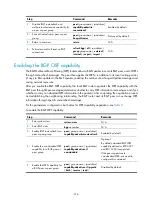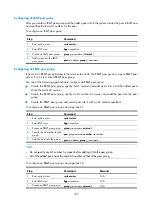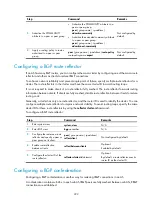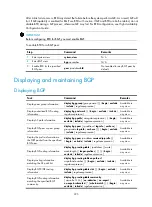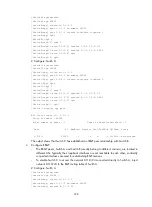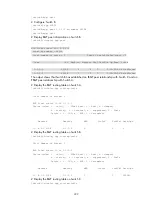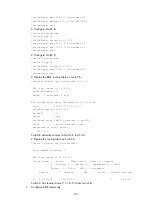
224
Step Command
Remarks
1.
Enter system view.
system-view
N/A
2.
Enable BGP and enter its view.
bgp
as-number
N/A
3.
Enable GR Capability for BGP.
graceful-restart
Disabled by default.
4.
Configure the maximum time
allowed for the peer to
reestablish a BGP session.
graceful-restart timer restart
timer
Optional.
150 seconds by default.
5.
Configure the maximum time to
wait for the End-of-RIB marker.
graceful-restart timer
wait-for-rib
timer
Optional.
180 seconds by default.
Enabling trap
After trap is enabled for BGP, BGP generates Level-4 traps to report important events. The generated
traps are sent to the information center of the device. The trap output rules (whether to output the traps
and the output direction) are determined according to the information center configuration. (For
information center configuration, see
Network Management and Monitoring Configuration Guide
.)
To enable trap:
Step Command
Remarks
1.
Enter system view.
system-view
N/A
2.
Enable trap for BGP.
snmp-agent trap enable bgp
Optional.
Enabled by default.
Enabling logging of peer state changes
Step Command
Remarks
1.
Enter system view.
system-view
N/A
2.
Enter BGP view.
bgp
as-number
N/A
3.
Enable the logging of peer
state changes globally.
log-peer-change
Optional.
Enabled by default.
4.
Enable the logging of peer
state changes for a peer or
peer group.
peer
{
group-name
|
ip-address
}
log-change
Optional.
Enabled by default.
Configuring BFD for BGP
BGP maintains neighbor relationships based on the keepalive timer and holdtime timer, which are set in
seconds. BGP defines that the holdtime interval must be at least three times the keepalive interval. This
slows down link failure detection; once a failure occurs on a high-speed link, a large quantity of packets
will be dropped. BFD is introduced to solve this problem. It detects links between neighbors quickly to
reduce convergence time upon link failures.







